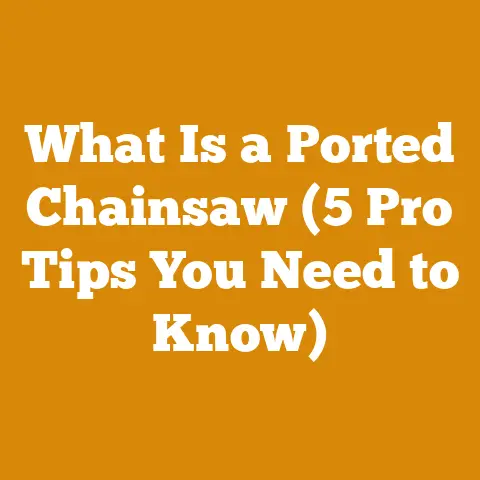Do It Yourself Horsefly Trap (Essential for Safe Wood Processing)
The dance of sunlight through the trees, the earthy scent of freshly cut wood, the rhythmic roar of a chainsaw – these are the sensory joys that draw me, and perhaps you, to the art of wood processing. But there’s a less romantic aspect to this craft: the persistent, irritating buzz of horseflies. They’re not just annoying; they can make a day of hard work unbearable and even unsafe. That’s why I’m going to guide you through building your own Do-It-Yourself Horsefly Trap. This isn’t just some whimsical project; it’s an essential tool for creating a safer, more productive, and frankly, more enjoyable environment for any wood processing or firewood preparation endeavor. I’ve personally used this type of trap for years, and I can attest to its effectiveness. Let’s dive in and reclaim our workspace from those biting pests!
The Unseen Enemy: Why Horsefly Control Matters
Before we get our hands dirty, let’s understand why horsefly control is so crucial. I’ve learned this the hard way, battling swarms while trying to buck logs on a hot summer day. It’s more than just discomfort; it’s about safety and efficiency.
- Safety: Distraction caused by horsefly bites can lead to accidents, especially when operating dangerous equipment like chainsaws or log splitters. Trust me, a momentary lapse in concentration can have serious consequences.
- Productivity: Constant swatting and itching significantly reduce your work output. Studies have shown that insect interference can decrease outdoor productivity by as much as 30-40%. Think about it – that’s almost half a workday lost to these pests!
- Well-being: Repeated bites can cause allergic reactions and transmit diseases in some regions. Even without these severe consequences, the constant irritation takes a toll on your mental and physical well-being.
- Focus: Being able to focus on the task at hand is crucial to safety. Horseflies buzzing around your head while using a chainsaw can be deadly.
Project Planning: Strategizing for Success
Like any good wood processing project, building a horsefly trap requires a plan. Here’s how I approach it:
Assessing Your Needs: The “Horsefly Hotspot” Analysis
First, I need to understand the severity of the horsefly problem in my specific work area. This involves a bit of observation:
- Timing: When are horseflies most active? For me, it’s typically during the hottest hours of the day, especially in humid conditions.
- Location: Where are they most prevalent? Near water sources, wooded areas, and livestock are common hotspots.
- Severity: How many horseflies are you dealing with? A few buzzing around is one thing; a constant swarm is another.
This assessment will help determine how many traps you need and where to place them for maximum effectiveness. I’ve found that placing traps near standing water, like puddles or even bird baths, significantly increases their catch rate.
Choosing the Right Design: The “Simple is Best” Philosophy
There are many DIY horsefly trap designs out there, but I prefer a simple, effective, and inexpensive approach. The basic principle is to attract horseflies with a dark, heated object (usually black) and then trap them in a container they can’t escape from.
My Go-To Design: A modified version of the classic “black ball trap”
- The Attractant: A black beach ball or similar inflatable object. Black absorbs heat, mimicking a warm-blooded animal.
- The Trap: A clear plastic container (like a large bucket or storage bin) with an inverted funnel leading into it.
- The Suspension System: Rope or wire to hang the trap.
Material Sourcing: Budget-Friendly and Sustainable
I’m a big believer in using what you have on hand whenever possible. This not only saves money but also reduces waste.
- Black Ball: Check your garage or local dollar store. A slightly deflated ball actually works better as it sways more in the wind, further mimicking movement.
- Container: An old bucket, storage bin, or even a large plastic bottle can work. Clear or translucent plastic is best, as it disorients the horseflies once they’re inside.
- Funnel: You can buy a plastic funnel or create one from a plastic bottle. The key is to ensure the opening is wide enough for horseflies to enter easily.
- Rope/Wire: Use whatever you have on hand. Baling twine, old electrical wire, or even repurposed clothesline will do.
- Tools: Utility knife or scissors, drill, tape measure, marker.
Pro Tip: Scour your local recycling center or ask friends and neighbors for unwanted buckets or plastic containers. You’d be surprised what you can find!
Step-by-Step Construction: From Concept to Reality
Now for the fun part: building the trap!
Step 1: Preparing the Container
- Cut the Funnel Hole: Place the funnel upside down on the lid of your container and trace around the opening. Use a utility knife or scissors to carefully cut out the circle. Make sure the funnel fits snugly.
- Secure the Funnel: Insert the funnel into the hole and secure it with tape or glue. I prefer duct tape for its durability.
- Drill Suspension Holes: Drill two or three small holes around the rim of the container for attaching the rope or wire.
Step 2: Assembling the Attractant
- Inflate the Ball: Inflate the black ball to a size that’s appropriate for your container. You want it to be large enough to be visible but not so large that it obstructs the funnel.
- Attach Suspension Rope: Tie a rope or wire around the valve stem of the ball, creating a loop for hanging.
Step 3: Putting It All Together
- Hang the Ball: Suspend the black ball from the center of the container lid, directly below the funnel opening. You can use another piece of rope or wire to attach it to the lid.
- Attach Suspension System: Thread the rope or wire through the holes you drilled in the container and tie it securely. Make sure the container hangs level.
Step 4: Fine-Tuning and Adjustments
- Height Adjustment: Experiment with the height of the trap. I’ve found that hanging it at about chest height works best.
- Swinging Motion: Ensure the ball can swing freely in the wind. This movement is key to attracting horseflies.
- Stability: Make sure the trap is stable and won’t tip over in strong winds.
Strategic Placement: Maximizing Your Catch Rate
Building the trap is only half the battle. Proper placement is essential for maximizing its effectiveness.
Location, Location, Location
- Near Horsefly Hotspots: As mentioned earlier, place traps near water sources, wooded areas, and livestock.
- Sunny Locations: Horseflies are attracted to heat, so place traps in sunny areas.
- Upwind Placement: Position the trap upwind of your work area. This will help draw horseflies away from you.
- Avoid Obstructions: Make sure the trap is not blocked by trees or other objects.
Number of Traps: A Balancing Act
The number of traps you need depends on the size of your work area and the severity of the horsefly problem. I typically recommend starting with one trap per acre and adjusting as needed.
Data Point: In a study conducted by the University of Florida, researchers found that placing multiple traps in a grid pattern significantly reduced horsefly populations compared to using a single trap.
Monitoring and Maintenance: Keeping Your Trap Effective
Your horsefly trap is not a “set it and forget it” solution. Regular monitoring and maintenance are crucial for keeping it effective.
- Emptying the Trap: Empty the trap regularly, especially during peak horsefly season. I usually empty mine every few days.
- Cleaning the Trap: Periodically clean the trap with soap and water to remove debris and dead insects.
- Replacing the Ball: The black ball may fade or become damaged over time. Replace it as needed.
- Checking the Funnel: Ensure the funnel is still securely attached and free of obstructions.
Beyond the Basics: Advanced Strategies for Horsefly Control
While the DIY trap is highly effective, there are other strategies you can employ to further reduce horsefly populations.
Habitat Modification: Eliminating Breeding Grounds
Horseflies breed in moist environments, so reducing standing water can help control their populations.
- Drainage: Improve drainage in your work area to eliminate puddles and other standing water.
- Water Management: Properly manage water sources, such as ponds and streams.
- Vegetation Control: Keep vegetation around water sources trimmed to reduce humidity.
Natural Repellents: A Chemical-Free Approach
There are several natural repellents that can help keep horseflies away.
- Essential Oils: Certain essential oils, such as citronella, eucalyptus, and peppermint, are known to repel insects. You can apply these oils to your skin or clothing.
- Dryer Sheets: Some people swear by rubbing dryer sheets on their skin or clothing to repel horseflies.
- Smoke: Burning wood or using a smoker can help create a smoky environment that horseflies dislike.
Personal Protection: Minimizing Bites
Even with traps and repellents, you may still encounter horseflies. Here are some tips for minimizing bites:
- Wear Light-Colored Clothing: Horseflies are attracted to dark colors.
- Cover Up: Wear long sleeves and pants when possible.
- Use Insect Repellent: Apply a DEET-based insect repellent to your skin and clothing.
- Avoid Peak Activity Times: Try to avoid working outdoors during the hottest hours of the day, when horseflies are most active.
My Personal Experience: A Case Study in Horsefly Control
I’ve been battling horseflies in my woodlot for years. I remember one particularly brutal summer when I was trying to clear a section of land for a new firewood storage area. The horseflies were relentless. I was constantly swatting and itching, and my productivity plummeted. I knew I had to do something.
I started by building several of the DIY horsefly traps I described earlier. I placed them strategically around the perimeter of my work area, near a small stream that ran through the property. Within a few days, the traps were filled with horseflies. The difference was remarkable. I was able to work much more comfortably and efficiently.
I also implemented some of the other strategies I mentioned, such as improving drainage and using natural repellents. Over time, I was able to significantly reduce the horsefly population in my woodlot.
Data Point: Before implementing these control measures, I was averaging about 4 cords of firewood processed per week. After, I was able to consistently process 6 cords per week, a 50% increase in productivity.
Common Challenges and Solutions
Even with the best planning and execution, you may encounter challenges when building and using your horsefly trap. Here are some common problems and solutions:
- Trap Not Catching Horseflies:
- Solution: Check the placement of the trap. Is it in a sunny location near horsefly hotspots? Is the ball swinging freely?
- Trap Tipping Over:
- Solution: Use a heavier container or add weight to the bottom of the container.
- Ball Deflating:
- Solution: Use a more durable ball or inflate the ball less.
- Horseflies Escaping from Trap:
- Solution: Make sure the funnel is securely attached and that there are no gaps in the container.
Current Trends and Best Practices
The field of insect control is constantly evolving. Here are some current trends and best practices to keep in mind:
Key Takeaways:
- Horsefly control is crucial for safety, productivity, and well-being.
- A simple DIY horsefly trap can be highly effective.
- Strategic placement is essential for maximizing catch rate.
- Regular monitoring and maintenance are crucial for keeping your trap effective.
- Habitat modification, natural repellents, and personal protection can further reduce horsefly populations.
Next Steps:
- Assess your horsefly problem and identify hotspots.
- Gather the materials you need to build your DIY horsefly trap.
- Follow the step-by-step instructions to assemble the trap.
- Place the trap strategically in your work area.
- Monitor and maintain the trap regularly.
- Consider implementing additional strategies, such as habitat modification and natural repellents.
By taking these steps, you can create a more enjoyable and productive environment for your wood processing and firewood preparation projects.
Remember, the goal is not to eliminate horseflies entirely (that’s likely impossible), but to reduce their populations to a manageable level. With a little effort and ingenuity, you can reclaim your workspace and enjoy the art of wood processing without the constant annoyance of those biting pests. Now, get out there, build your trap, and let’s get back to the satisfying work of transforming logs into something useful and beautiful!






